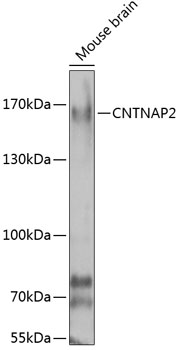Cell Biology Antibodies 11
Anti-CNTNAP2 Antibody (CAB7466)
- SKU:
- CAB7466
- Product Type:
- Antibody
- Reactivity:
- Mouse
- Host Species:
- Rabbit
- Isotype:
- IgG
- Antibody Type:
- Polyclonal Antibody
- Research Area:
- Cell Biology
Description
| Antibody Name: | Anti-CNTNAP2 Antibody |
| Antibody SKU: | CAB7466 |
| Antibody Size: | 20uL, 50uL, 100uL |
| Application: | WB |
| Reactivity: | Mouse |
| Host Species: | Rabbit |
| Immunogen: | Recombinant fusion protein containing a sequence corresponding to amino acids 180-400 of human CNTNAP2 (NP_054860.1). |
| Application: | WB |
| Recommended Dilution: | WB 1:500 - 1:2000 |
| Reactivity: | Mouse |
| Positive Samples: | Mouse brain |
| Immunogen: | Recombinant fusion protein containing a sequence corresponding to amino acids 180-400 of human CNTNAP2 (NP_054860.1). |
| Purification Method: | Affinity purification |
| Storage Buffer: | Store at -20'C. Avoid freeze / thaw cycles. Buffer: PBS with 0.02% sodium azide, 50% glycerol, pH7.3. |
| Isotype: | IgG |
| Sequence: | GCSY WADV INFD GHVV LPYR FRNK KMKT LKDV IALN FKTS ESEG VILH GEGQ QGDY ITLE LKKA KLVL SLNL GSNQ LGPI YGHT SVMT GSLL DDHH WHSV VIER QGRS INLT LDRS MQHF RTNG EFDY LDLD YEIT FGGI PFSG KPSS SSRK NFKG CMES INYN GVNI TDLA RRKK LEPS NVGN LSFS CVEP YTVP VFFN ATSY LEVP GRLN QDLF SVSF Q |
| Gene ID: | 26047 |
| Uniprot: | Q9UHC6 |
| Cellular Location: | Cell projection, Membrane, Single-pass type I membrane protein, axon |
| Calculated MW: | 11kDa/148kDa |
| Observed MW: | 160kDa |
| Synonyms: | CNTNAP2, AUTS15, CASPR2, CDFE, NRXN4, PTHSL1 |
| Background: | This gene encodes a member of the neurexin family which functions in the vertebrate nervous system as cell adhesion molecules and receptors. This protein, like other neurexin proteins, contains epidermal growth factor repeats and laminin G domains. In addition, it includes an F5/8 type C domain, discoidin/neuropilin- and fibrinogen-like domains, thrombospondin N-terminal-like domains and a putative PDZ binding site. This protein is localized at the juxtaparanodes of myelinated axons, and mediates interactions between neurons and glia during nervous system development and is also involved in localization of potassium channels within differentiating axons. This gene encompasses almost 1.5% of chromosome 7 and is one of the largest genes in the human genome. It is directly bound and regulated by forkhead box protein P2 (FOXP2), a transcription factor related to speech and language development. This gene has been implicated in multiple neurodevelopmental disorders, including Gilles de la Tourette syndrome, schizophrenia, epilepsy, autism, ADHD and mental retardation. |
| UniProt Protein Function: | CNTNAP2: May play a role in the formation of functional distinct domains critical for saltatory conduction of nerve impulses in myelinated nerve fibers. Seems to demarcate the juxtaparanodal region of the axo-glial junction. Associates with KCNA2. Predominantly expressed in nervous system. Belongs to the neurexin family. 2 isoforms of the human protein are produced by alternative splicing. |
| UniProt Protein Details: | Protein type:Motility/polarity/chemotaxis; Membrane protein, integral Chromosomal Location of Human Ortholog: 7q35 Cellular Component: axolemma; cell surface; early endosome; Golgi apparatus; membrane; voltage-gated potassium channel complex Molecular Function:enzyme binding; protein binding Biological Process: adult behavior; brain development; cerebral cortex development; clustering of voltage-gated potassium channels; learning; limbic system development; neurite development; social behavior; striatum development; thalamus development; vocal learning Disease: Autism, Susceptibility To, 15; Cortical Dysplasia-focal Epilepsy Syndrome |
| NCBI Summary: | This gene encodes a member of the neurexin family which functions in the vertebrate nervous system as cell adhesion molecules and receptors. This protein, like other neurexin proteins, contains epidermal growth factor repeats and laminin G domains. In addition, it includes an F5/8 type C domain, discoidin/neuropilin- and fibrinogen-like domains, thrombospondin N-terminal-like domains and a putative PDZ binding site. This protein is localized at the juxtaparanodes of myelinated axons, and mediates interactions between neurons and glia during nervous system development and is also involved in localization of potassium channels within differentiating axons. This gene encompasses almost 1.5% of chromosome 7 and is one of the largest genes in the human genome. It is directly bound and regulated by forkhead box protein P2 (FOXP2), a transcription factor related to speech and language development. This gene has been implicated in multiple neurodevelopmental disorders, including Gilles de la Tourette syndrome, schizophrenia, epilepsy, autism, ADHD and mental retardation.[provided by RefSeq, Mar 2010] |
| UniProt Code: | Q9UHC6 |
| NCBI GenInfo Identifier: | 17433089 |
| NCBI Gene ID: | 26047 |
| NCBI Accession: | Q9UHC6.1 |
| UniProt Secondary Accession: | Q9UHC6,Q14DG2, Q52LV1, Q5H9Q7, Q9UQ12, D3DWG2, |
| UniProt Related Accession: | Q9UHC6 |
| Molecular Weight: | 11,899 Da |
| NCBI Full Name: | Contactin-associated protein-like 2 |
| NCBI Synonym Full Names: | contactin associated protein-like 2 |
| NCBI Official Symbol: | CNTNAP2 |
| NCBI Official Synonym Symbols: | CDFE; NRXN4; AUTS15; CASPR2; PTHSL1 |
| NCBI Protein Information: | contactin-associated protein-like 2 |
| UniProt Protein Name: | Contactin-associated protein-like 2 |
| UniProt Synonym Protein Names: | Cell recognition molecule Caspr2 |
| Protein Family: | Contactin-associated protein |
| UniProt Gene Name: | CNTNAP2 |
| UniProt Entry Name: | CNTP2_HUMAN |
View AllClose







